人教版七年级上册英语动词分类及用法+练习.doc
人教版七年级上册英语动词分类及用法+练习

七年级英语动词分类及用法动词(v.): 一般情况下,按照作用和用途,英语动词可分为三类:be动词、情态动词,行为动词、助动词。
be动词表示状态, 情态动词表示说话人的情绪态度或看法,行为动词表示动作,助动词没有实际词意,只起语法作用。
一、be动词:英语中be动词也叫系动词,基本形式有am, is, are 三种。
其用法如下:我(I)用am,你(you)用are,is用于他(he),她(she),它(it);单数名词用is,复数名词全用are.变疑问,往前提,句末问号莫丢弃。
变否定,更容易, be后not莫忘记。
疑问否定任你变,句首大写莫迟疑。
be动词练习1. I ________ from Australia.2. She _______ a student.3. Jane and Tom _________ my friends.4. My parents _______ very busy every day.5. Where _________ you from?6._________ they your new friends?7. The girl______ Jack's sister.8. The dog _______ tall and fat.9. Jack’s friend ______ in Class One.10. Where _____ your mother? She ______ at home.11. Whose dress ______ this?12. That ______ my red skirt.14. These _____ buses.15. Some tea ______ in the glass.16. Gao Shan's shirt _______ over there.17. ______ David and Helen from England?18. We ____ friends.19. The two cups of milk _____ for me.20. The man with big eyes _______ a teacher.二、助动词:本身无实意,只有实意动词作谓语时才涉及使用,起到辅助作用。
(2021年整理)初一英语动词解析及练习

初一英语动词解析及练习编辑整理:尊敬的读者朋友们:这里是精品文档编辑中心,本文档内容是由我和我的同事精心编辑整理后发布的,发布之前我们对文中内容进行仔细校对,但是难免会有疏漏的地方,但是任然希望(初一英语动词解析及练习)的内容能够给您的工作和学习带来便利。
同时也真诚的希望收到您的建议和反馈,这将是我们进步的源泉,前进的动力。
本文可编辑可修改,如果觉得对您有帮助请收藏以便随时查阅,最后祝您生活愉快业绩进步,以下为初一英语动词解析及练习的全部内容。
动词专项练习一动词的种类:四种(一)行为动词(如 play study run ) 有具体动作意义(二)连系动词(如 is am are get feel keep stay )等,后用形容词作表语(三)情态动词 (如 can may must should would)等,表示禁止、命令、请求等意义,后接动词原形(四)助动词(如 be +v –ing 中的be ;Do you …。
?中的do ;He doesn't like .中的doesn’t; Did you have…。
?中的did )只起语法作用,无意义,不必翻译二动词的形式有(一)动词原形如play study run(二)动词过去式如 played studied ran(三)动词三单形式如 plays studies runs(四)动词ing 形式 (也叫动名词或现在分词)如 playing studying running(五)动词不定式(即 to +动词原形)如 to play to study to run 三选择动词正确形式的方法(一)主语后需填动词时,注意动词的时态,主要从该句中的时间状语来判断,有时也要从上下语境来判断。
如 I (like ) comedies ,but I don’t like thrillers 从后句I don't like 可判断前句是一般现在时,所以根据主语I 填入like 的原形注句子的时态有 1、一般现在时,常与often ; always .once a week every day 等词或短语连用2,现在进行时,主语+ be+v-ing 形式,常与look , listen , over there now 祈使句等连用3 一般将来时用现在进行时来表示即主语+be +v ing 形式,常与 next Sunday tomorrow for vacation 等词连用4。
人教版七年级上册英语动词汇总
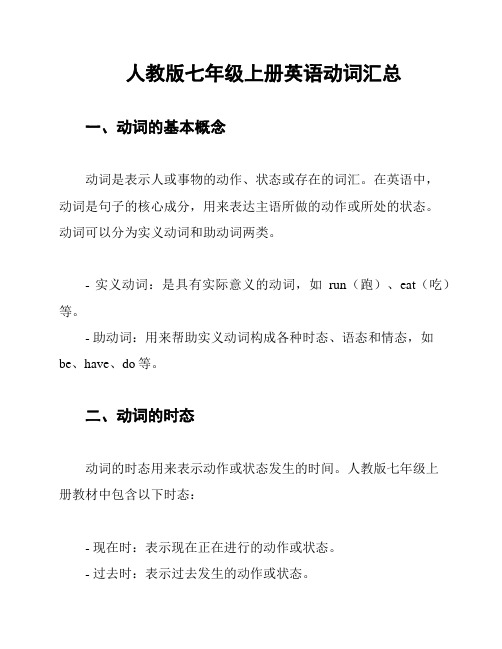
人教版七年级上册英语动词汇总
一、动词的基本概念
动词是表示人或事物的动作、状态或存在的词汇。
在英语中,
动词是句子的核心成分,用来表达主语所做的动作或所处的状态。
动词可以分为实义动词和助动词两类。
- 实义动词:是具有实际意义的动词,如run(跑)、eat(吃)等。
- 助动词:用来帮助实义动词构成各种时态、语态和情态,如be、have、do等。
二、动词的时态
动词的时态用来表示动作或状态发生的时间。
人教版七年级上
册教材中包含以下时态:
- 现在时:表示现在正在进行的动作或状态。
- 过去时:表示过去发生的动作或状态。
- 将来时:表示将来要发生的动作或状态。
三、常用动词
下面是人教版七年级上册教材中常用的动词列表:
1. be(是、存在)
2. have(有)
3. do(做)
4. go(去)
5. study(研究)
6. play(玩)
7. like(喜欢)
8. want(想要)
9. eat(吃)
10. drink(喝)
11. sleep(睡觉)
12. watch(观看)
13. read(阅读)
14. write(写)
15. listen(听)
16. speak(说)
以上是人教版七年级上册英语动词的概况及常用动词列表,希
望能对你的研究有所帮助。
注:本文档内容为根据人教版七年级上册教材整理的动词汇总,仅供参考使用。
如有引用,请务必确认并注明出处。
初中英语人教版动词

七年级上册动词are /a:/ v・是am /«m/ v.是is /iz/ v.是spell /spel/ v.用字母拼;拼写say /sei/ v.说;讲see /si:/ v.理解:明白can /keen/ modal v.能:会meet /mi:t/ v.遇见:相逢have /heev/ v.经受:经历excuse /ik'skju:z/ v.原谅;宽恕thank /0aer〕k/ v.感谢:谢谢help /help/ v.&n.帮助;援助ask/a:sk/v.请求:要求:询问find /faind/ v. 〔ii去分词found〕找到;发现call /lo:l/ v.〔给……〕打lost /lost/ v.〔动词lose的过去式〕遗失;丧失must /mAst/ modal v.必须come /kAm/ v.来:来到know /neu/ v.知道:了解have /heev/ v.有let /let/ v.允许;让go /geu/ v.去;走get /get/ v.去取〔或带来〕;得到play /plei/ v.参加〔比赛或运动〕:玩耍sound /saund/ v.听起来好似watch /wot// v.注视;观看has /haez/ v. 〔have的第三人称单数形式〕有love /I AV/ v.&n.爱:喜爱like /laik/ v.喜欢;喜爱eat /i:t/ v.吃want /wont/ v.需要:想要be/bi:/ v.变成need /ni:d/ v.需要look/luk/ v.看:看上去take /teik/ v.买下;拿:取buy/bai/ v.购置:买sell /sei/ v.出售;销售:卖finish/'finiJ7v.完成;做好to /tu:/常用于原形动词之前,该动词为不左式do /du:/ aux v. &v.用于否泄句疑问句:做:干七年级下册动词join [d^Din] v.参加;参加dance [da:ns] v.跳舞;舞蹈swim [swim] v•游泳sing [sirj] v•唱;唱歌paint [peint] v•画画speak spi:k] v•说;说话show [fau] n.演岀;表演v.展示;draw [do:] v.画tell [tel] v. n.讲述;告诉write [rait] v.写作,写字talk [b:k] v. n.说话;谈话make [meik] v•使或为;制造teach [ti:tj] v.教,讲授•锻炼;练习shower [Jaue] n. v.淋浴;淋浴器〔间〕work [w3:k] n.& v•工作brush [brAj] v•刷run [rAn] v.跑;奔walk [wo:k]行走涉行clean. [kli:n] v.清扫;弄干净;adj.干净的taste [teist] v.有…的味道;品尝n..味道;ride[raid]v.骑n•旅rode. [raud]ridden.[ndn.] 七年级下册by [bai]通过,被drive [draiv]开车stop [stop]停止afraid [efreid]害怕;惧怕leave [li: v]离开;left 〔lea ve 的过去式〕dream [dri:m]梦想;睡梦arrive [araiv]到达listen [lis〔e〕n]听;倾听fight [fait]打架;战斗wear [wea]穿;戴bring [brirj]带来;取来out [aut]外出relax [ril«ks]放松;休息read [ri:d]读;阅读remember [rimembe] i己住;i己起follow [foleu]遵循;跟随keep [ki:p]保持;保存learn cut [kAt] v.砍;切kill [kil] v.杀死;弄死use [ju:z] v.使用;运用wash [WD J] v•洗race [reis]竞赛miss [mis] v思念•思念wish [wij] v.希望rain [rein] v或n,下雨;雨水snow [sneu] F雪;雪Snow cook [kuk]做饭visit [vizit]organize^□:rganaiz]组织,筹备upset[Ap'set]难过,失望拜访;参观sit [sit]坐pay [pei]付费across [ekros]过;穿过turn [t3:n]转向;翻spend [spend]花(时间、钱等)climb [klaim]爬enjoy [ind^Di]享受;喜爱put [put]放criminal [krimin(a)l]犯罪describe [diskraib]描述order[o:de]点菜;命令blow [bleu]吹feed [fi:d]喂养;饲养milk [milk]挤奶grow [greu]种植;生长;发ff pick [pik]采;摘worry [WAH]担忧;担忧as [aez; az]作为,当做stay[stei]停留away [awei]离开shout [faut]呼叫,喊叫jump [d3Amp]跳跃wake [weik]弄醒,醒startmove[mu:v]移动[sta:t]开始,着手fly [flai]飞hear(heard)[hie]听到;听见could[kud]能;可以shop [JDp] V•购物cross [kros]交叉八年级上册seem [si:m] vi・似乎:好似try [trai] v.尝试;设法;努力(try to do sth. /try doing sth.) wonder rw/\nd3(「)] v.惊奇;想知道;疑心wait [weit] v.等;等待(wait for)dislike [dis'laik] v.不喜欢:厌恶n.不喜爱;厌恶;反感decide [di'said] v.决定;选定(decide to do sth.) die [dai]v.死:枯竭;消失give [giv] v.给;赠予:送win [win] v.贏:赢得:获胜;获得n.胜利care [kee(r)] v.关心:担忧;照顾;在乎touch [tAtJ] vt・触摸;感动reach 到达;伸岀;达成;取得联系:延伸;〔伸手〕去够break [breik] v.打碎;折断:违背:解决;中断laugh[la:f] v.发笑:笑;嘲笑n.笑声;笑;笑料which pron.哪一个:哪些share [Jee〔r〕] vt.分享,共享;分配:共有should [Jad] aux.应该:可能:应当;将要close [kleos]v.关;合拢:不开放:停业choose [tju:z] v.选择:决定act [aekt] v.行动;表演makeup编造stand [steend] v.站立:忍受happen [’heepen] vi.发生:碰巧:出现:偶遇expect [ik'spekt] v.预期;期待:盼望appear [$pia〔「〕] vi.出现;出版:显得become [bi'kAm] v.变成:成为may [mei] aux.可以,能够;可能,也许might [mait]aux.可能;也许;may的过去式send [send]邮寄,发送able [' ebal]能够discuss [di' skAs]讨论,商量promise ['pramis] 承诺,诺言improve [im1 pruv]改良,改善plant[plaent]种植,植物believe [bi'li:v]相信disagree[.disa'gri:]不同意fall [fo:l]倒塌:跌倒peel[pi:l] vt.剥落:削皮add[asd]增加celebraselibreit]庆祝:庆贺serve[s3:rv] 接待,效劳pour [po:r] pour[po:r]倒;倾倒prepare [prfpe「]v•预备:准备hang[haeo]悬挂;〔使〕低垂catch[kaetl]赶上:抓住:捕捉invite [in'vait]邀请accept[9k'sept]接受; refuse [ri'fju:z]拒绝reply[ri'plai]答复,回复forward['fD:rw9rd]转交:发送,向前的delete [di'li:t]删除trust[trAst]相信,信任advise[ed'vaiz] v 劝告,建议solve [sa:lv]解决;解答advice[9d'vaisi]劝告,建议八年级下册matter [' maete] v.重要,要紧,有关系lie [lai] v.躺,平躺break [breik] n. &v.休息,暂停;打破hurt [he:t] v.伤害,损害,使受伤thit [hit] v. (hit/hit)碰撞,打,打击:挤;按breathe [bri:d] v.呼吸mean [mi:n] v.意味着,意思是,意欲control [ken'treul] v.控制,支配,操纵cheer [tfia] v.欢呼raise [reiz] v.抬起,举起,筹集,征集repair [ri'pm] v.修理,修补fix [fiks] v.修理,安装imagine [i' meed^in] v.想象,设想open 「网6n] v.翻开carry ['kaeri] v.携带,搬运train [trein] v.训练,培养understand [, Anda' staend] v. 理解fold [feuld] v.对折,折叠sweep/sw i:p/v.(swept/swept)扫;清扫throw [Oreo] v.扔,投掷pass [pa:s] v.前行,经过,批准borrow ['boreu] v.借,借用lend [lend] v.借给,借岀hate [heit] v.憎恶,讨厌waste [weist] v.浪费,消耗provide [pre'vaid] v.提供,供给,供给depend [di' pend] v.取决于,依靠,依赖develop [di' velep] v.开展,壮大,开发,研制drop [drop] v.落下,跌落allow [e'lau] v.允许,准许guess [ges] v.猜想,估计deal [di:l] v.处理,应付argue [ a:gju:] v.争论,争吵offer ['a:fer] v.提供,自愿给予communicate [ka1 mju:nikeit] v.沟通,通信「通讯explain [ik'splein] v.讲解,解释,说明copy [' kopi] v.复制return [ri't3:n] v.回来,返回,归还compete [kem'piit] v.比赛,竞争continue [ken 'tinju:] v.继续,连续compare [kem'pee] v.比拟push/puj/v.鞭策,催促,推动begin [bT gin] v. (began)开始OOOOOOOOOOOOOOOOOreport [ri poit] v.报导,报告beat [bi:t] v.(beat)敲打,打败rise [raiz] v. (rose)上升,升起realize ['ri:Blaiz] v.认识到,了解shoot [fu:t]v.(shot)投篮,射击,发射remind [ri1 maind] v.提醒,使想起hide [haid] v.躲藏,隐藏excite [ik'sait] v.使冲动,使兴奋fit [fit] v.适合,合身marry [1 maeri] v.与某人结婚cheat [tfi:t] v.欺骗,愚弄shine [fain] v.照糠,发光protect [pre1 tekt] v.保护include [in klu:d] v.包括,包含succeedfssk sizd] v.成功,实现目标,完成achieve[e'tjiiv] v.完成,实现weigh [wei] v.称…重量hurry ['hAri] v.匆忙,赶快belong [bi' brj] v.属于introduce [, intra dju:s] v.介绍,传入,引进invent [in' vent] v.创造,创造encourage [in' kAridj] v.鼓励,鼓励collect [ke' lekt] v.收集ride [raid] n. &v.骑,乘:(短途)旅程search [s3:tj] v.搜索,搜查consider [ken'side] v.仔细考虑,思考,注视,hold [heuld] v.拥有,抓住九年级全一册repeat v.重复:重做note /n n.笔记;记录v.注意;指出pronounce v.发音increase v.增加:增长connect v.(使)连接:与…有联系review v. & n.回忆:复习steal v. 偷;窃取lay v.放宜:安放:产(卵):下admire v.欣赏;仰慕flie v.平躺:处于punish v.处分:惩罚warn v.警告:告诫spread v.传播:展开n.蔓延;传播suggest v.建议;提议dare v.敢于;胆敢require v.需要;要求influence v. & n.影响produce v.生产;制造:岀产process v.加工:处理avoid v.防止:回避paint v.用颜料画:刷漆polish v.磨光;修改;润色complete v.完成list v.列表;列淸单n.名单;淸单mention v.提到;说到boil v.煮沸;烧开translate v.翻译lock v.锁上;锁住divide v.分开:分散smoke /sm@Uk/ v.冒烟:吸烟n.烟pierce v.扎;刺破;穿透lift v.举起;抬高regret v.感到遗憾:懊悔manage v.完成(困难事):应付(困难局而) educate v.教育:教导enter v.进来:进去afford v.承当得起(后果);买得起recycle v.回收利用;再利用shall /S v.将要;将会overcome v.克服;战胜graduate v.毕业;获得学位congratulate v.祝贺fail v.失败:未能(做到) recall v.回忆起:回想起oversleep v.(overslept z overslept)睡过头;睡得太久attend V.出席;参加valuable v adj. 很有用珍贵。
人教版新目标七年级上英语动词专项精讲与练习

七年级上英语动词专项讲与练1、Be 动词Be动词要根据句中主语的人称和数而变化。
它有三种形式:am, is , are我用am你用are,is跟着他她它,单数主语用is,复数主语都用are。
如:I _________a teacher. Your mother and I ______teachers.My brother _______ at school, and my parents _______at home.Lucy and Lily ________ in Class One, Grade Two.You _______a good boy.2、实义动词:一般现在时表示动作经常反复地发生,第三人称单数(he, she , it, Tom等)作主语,谓语动词要加″s″ 或″es″,这种动词形式简称为三单动词,记住:三单做主语,实义动词加S, 其它人称做主语,实义动词用原形。
They _______(watch )TV in the evening.He_______(watch )TV in the evening附:动词第三人称单数的构成规则1)一般情况下加s get—gets like---likes2)以s, x, ch, sh, o结尾的加es: watch---watches go---goes do---does3)以辅音字母加y结尾的,改y为i,加es carry---carries特殊:have---has3情态动词can,may, must后+动词用原形。
如:I can say my ABC. I must find it.非谓语动词的用法:1、let后用动词原形即:let sb do 让某人做某事例:Let’s play soccer.2、like doing/to do sth 喜欢做某事I like watching /to watch TV. 介词后+doing形式,如:be good at doing 擅长做某事,Thanks for doing 为---感谢What about /How about doing 关于—怎么样?3、want to do sth 想要做某事need to do sth 需要做某事4、help sb do (to do) sth帮助某人做某事== help+sb. +with sth.5、ask sb. to do sth. 告诉/要求某人做某事巩固训练一、用be的适当形式填空。
人教版七年级上册英语动词分类及用法+练习(无答案)

七年级英语动词分类及用法动词(v.): 一般情况下,按照作用和用途,英语动词可分为三类:be动词、情态动词,行为动词、助动词。
be动词表示状态, 情态动词表示说话人的情绪态度或看法,行为动词表示动作,助动词没有实际词意,只起语法作用。
一、be动词:英语中be动词也叫系动词,基本形式有am, is, are 三种。
其用法如下:我(I)用am,你(you)用are,is用于他(he),她(she),它(it);单数名词用is,复数名词全用are.变疑问,往前提,句末问号莫丢弃。
变否定,更容易, be后not莫忘记。
疑问否定任你变,句首大写莫迟疑。
be动词练习1. I ________ from Australia.2. She _______ a student.3. Jane and Tom _________ my friends.4. My parents _______ very busy every day.5. Where _________ you from?6._________ they your new friends?7. The girl______ Jack's sister.8. The dog _______ tall and fat.9. Jack’s friend ______ in Class One.10. Where _____ your mother? She ______ at home.11. Whose dress ______ this?12. That ______ my red skirt.14. These _____ buses.15. Some tea ______ in the glass.16. Gao Shan's shirt _______ over there.17. ______ David and Helen from England?18. We ____ friends.19. The two cups of milk _____ for me.20. The man with big eyes _______ a teacher.二、助动词:本身无实意,只有实意动词作谓语时才涉及使用,起到辅助作用。
动词用法小结22-23人教版英语七年级上册

• 2. 使用V-ing 的情况: • (1)介词+doing • (what/how about, think about, thank you for
doing) • (2) like/ finish / be busy +doing • 3. 使用不定式 to do 的情况: • (1). want/ need (sb.) to do sth. • (2). like to to • (3). help sb. (to) do sth. (to 可以省略) • (4). teach/ ask sb. to do sth.
----Yes , I_c_a_n___. 4. She can _p_la__y__ (play/ plays) basketball.
需要注意的是:
情态动词和be动词都可以直接加not变为否 定句,或直接提前变为疑问句
be 动词 情态动词
直接变化
He isn't my classmate.
.一、用be的适当形式填空
1. Where ____ Mr. Lee ? 2. Michael and I ____ good friends. 3. The green sweater ____ big. 4. Beijing ____ in China. 5. This pair of shoes_____for Lingling. 6. The girl ____ Peter's cousin. 7. They _____ good students. 8. There _____ some tomatoes in the
basket(篮子). 9. There ____ some orange in the cup.
英语动词分类讲解及练习(有答案)
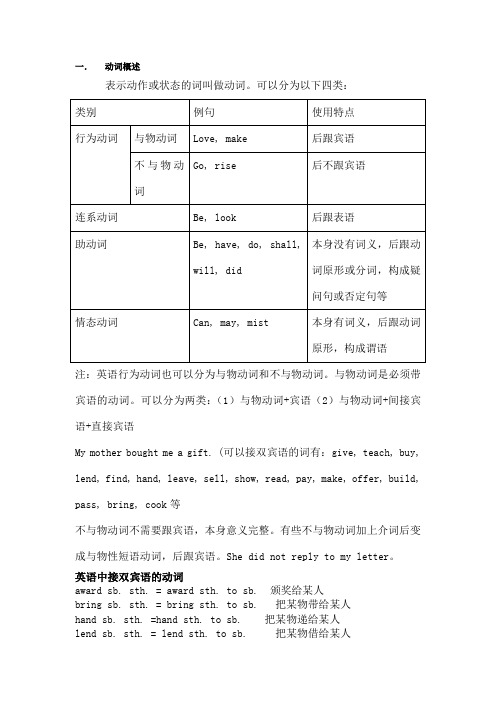
一.动词概述表示动作或状态的词叫做动词。
可以分为以下四类:注:英语行为动词也可以分为与物动词和不与物动词。
与物动词是必须带宾语的动词。
可以分为两类:(1)与物动词+宾语(2)与物动词+间接宾语+直接宾语My mother bought me a gift. (可以接双宾语的词有:give, teach, buy, lend, find, hand, leave, sell, show, read, pay, make, offer, build, pass, bring, cook等不与物动词不需要跟宾语,本身意义完整。
有些不与物动词加上介词后变成与物性短语动词,后跟宾语。
She did not reply to my letter。
英语中接双宾语的动词award sb. sth. = award sth. to sb. 颁奖给某人bring sb. sth. = bring sth. to sb. 把某物带给某人hand sb. sth. =hand sth. to sb. 把某物递给某人lend sb. sth. = lend sth. to sb. 把某物借给某人mail sb. sth. = mail sth. to sb. 把某物寄给某人offer sb. sth. = offer sth. to sb. 将某物给某人owe sb. sth. = owe sth. to sb. 欠某人某物pass sb. sth. = pass sth. to sb. 把某物递给某人pay sb. sth. = pay sth. to sb. 付给某人某物(钱)post sb. sth. = post sth. to sb. 把某物寄给某人read sb. sth. = read sth. to sb. 把某物读给某人听return sb.sth. = return sth. to sb. 把某物还给某人send sb. sth. = send sth. to sb. 把某物送给某人sell sb. sth. = sell sth. to sb. 把某物卖给某人serve sb. sth. = serve sth. to sb. 拿某物招待某人show sb. sth. = show sth. to sb. 拿某物给某人看take sb. sth. = take sth. to sb. 把某物拿给某人teach sb. sth. = teach sth. to sb. 教某人某物tell sb. sth. = tell sth. to sb. 告诉某人某情况throw sb. sth. = throw sth. to sb. 把某物扔给某人write sb. sth. = write sth. to sb. 给某人写信2、双宾语易位时需借助介词for的常用动词book sb. sth. = book sth. for sb. 为某人预定某物buy sb. sth. = buy sth. for sb. 为某人买某物choose sb. sth. = choose sth. for sb. 为某人选某物cook sb. sth. = cook sth. for sb. 为某人煮某物draw sb. sth. = draw sth. for sb. 为某人画某物fetch sb. sth. = fetch sth. for sb. 为某人去取某物find sb. sth. = find sth. for sb. 为某人找到某物fix sb. sth. = fix sth. for sb. 为某人准备某物get sb. sth. = get sth. for sb. 为某人拿来某物make sb. sth. = make sth. for sb. 为某人做某物order sb. sth. = order sth. for sb. 为某人订购某物pick sb. sth. = pick sth. for sb. 为某人采摘某物prepare sb. sth. = prepare sth. for sb. 为某人准备某物save sb. sth. = save sth. for sb. 为某人留某物sing sb. sth. = sing sth. for sb. 为某人唱某物(歌)spare sb. sth. = spare sth. for sb. 为某人让出某物steal sb. sth. = steal sth. for sb. 为某人偷某物3、有的动词后接的双宾语易位时,既可用介词to引出间接宾语,也可用介词for引出间接宾语,含义相同。
人教版英语七年级上册最全动词短语句型总结

人教版英语七年级上册最全动词短语句型总结1. 动词短语的使用及分类动词短语包括动词及其后面的副词、介词短语和名词,构成动词的完整意义。
1.1 及物动词短语及物动词短语是指需要宾语的动词,例如:- look at- like- have- help with1.2 不及物动词短语不及物动词短语是指无需宾语的动词,例如:- run away- sit down- stand up1.3 双宾语动词短语双宾语动词短语是指既可以带直接宾语,也可以带间接宾语的动词,例如:- buy sb. sth.- show sb. sth.- teach sb. sth.2. 动词短语句型的使用动词短语还可以用来构造特定的句型,在句子中起到重要的作用。
2.1 There be 句型There be 句型是一种表示“存在”的句型,构成方式为 there + be + 宾语,例如:- There is a book on the desk.- There are some flowers in the garden.2.2 动词不定式的使用动词不定式可用于表示目的,结果,意愿等,构成方式为:动词不定式前通常带有 to,例如:- I want to go to the cinema.- She likes to read books.2.3 动词-ing 形式的使用动词-ing 形式可用来表示进行中的动作,构成方式为:动词 + -ing,例如:- He is reading a book.- They are playing basketball.3. 表示意愿及请求的句型动词短语还可以用来构造表示意愿及请求的句型。
3.1 Would like 句型Would like 句型表示愿望或请求,构成方式为:主语 + would like + 宾语,例如:- I would like a cup of tea.- Would you like to go to the cinema with me?3.2 Could you 句型Could you 句型表示礼貌的请求,构成方式为:Could you + 动词原形 + 其他,例如:- Could you pass me the salt, please?- Could you close the window, please?4. 总结动词短语的种类和句型用法是英语研究的重点和难点,需要认真总结和掌握。
(完整版)人教版七年级上册英语动词分类及用法+练习(无答案)
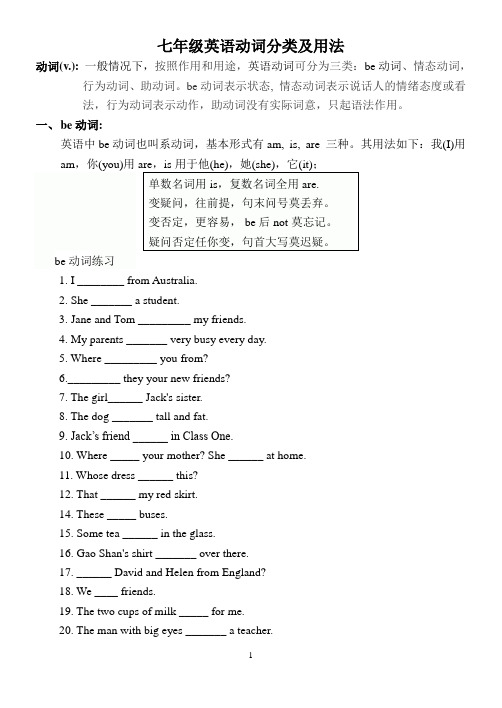
七年级英语动词分类及用法动词(v.): 一般情况下,按照作用和用途,英语动词可分为三类:be动词、情态动词,行为动词、助动词。
be动词表示状态, 情态动词表示说话人的情绪态度或看法,行为动词表示动作,助动词没有实际词意,只起语法作用。
一、be动词:英语中be动词也叫系动词,基本形式有am, is, are 三种。
其用法如下:我(I)用am,你(you)用are,is用于他(he),她(she),它(it);单数名词用is,复数名词全用are.变疑问,往前提,句末问号莫丢弃。
变否定,更容易, be后not莫忘记。
疑问否定任你变,句首大写莫迟疑。
be动词练习1. I ________ from Australia.2. She _______ a student.3. Jane and Tom _________ my friends.4. My parents _______ very busy every day.5. Where _________ you from?6._________ they your new friends?7. The girl______ Jack's sister.8. The dog _______ tall and fat.9. Jack’s friend ______ in Class One.10. Where _____ your mother? She ______ at home.11. Whose dress ______ this?12. That ______ my red skirt.14. These _____ buses.15. Some tea ______ in the glass.16. Gao Shan's shirt _______ over there.17. ______ David and Helen from England?18. We ____ friends.19. The two cups of milk _____ for me.20. The man with big eyes _______ a teacher.二、助动词:本身无实意,只有实意动词作谓语时才涉及使用,起到辅助作用。
七年级上册英语知识点归纳动词

七年级上册英语知识点归纳动词七年级上册英语知识点归纳:动词动词是英语中最基本的词类之一,它可以表示动作、状态、事件或情感等概念。
在七年级上册的英语学习中,动词是学习的重点之一。
下面将对七年级上册英语中涉及到的动词知识点进行归纳。
一、动词的分类根据用法,动词可以分为四类:及物动词、不及物动词、系动词和助动词。
1. 及物动词及物动词是指需要与宾语搭配使用的动词,它们一般表示一个动作或事件的发生。
例如:Tom likes playing basketball.(Tom喜欢打篮球。
)在这句话中,play是及物动词,basketball是该动词的宾语。
2. 不及物动词不及物动词是指不需要与宾语搭配使用的动词,它们一般表示一个状态或事件的发生。
例如:I often get up early.(我经常早起。
)在这句话中,get up是不及物动词。
3. 系动词系动词是指用来联系主语和表语的动词,它们一般不能独立使用。
例如:The flowers look beautiful.(这些花看起来很美丽。
)在这句话中,look是系动词,beautiful是表语。
4. 助动词助动词是指用来辅助主要动词的动词,它们一般不能独立使用。
例如:I will go to school tomorrow.(我明天会去上学。
)在这句话中,will是助动词,go是主要动词。
二、动词的时态时态是指动词的时间关系,英语中主要有三种时态:现在时态、过去时态和将来时态。
1. 现在时态现在时态表示目前正在进行或经常发生的动作或状态。
例如:She usually goes to school by bike.(她通常骑自行车去上学。
)在这句话中,goes是现在时态。
2. 过去时态过去时态表示过去已经发生或已经结束了的动作或状态。
例如:He played football yesterday.(他昨天踢了足球。
)在这句话中,played是过去时态。
3. 将来时态将来时态表示将来要发生的动作或状态。
人教版初一上动词用法

人教版初一上动词用法在学习人教版初一英语的过程中,动词的用法是非常重要的一部分。
掌握好动词的用法,对于理解句子结构、表达准确的意思以及进行有效的交流都有着至关重要的作用。
接下来,让我们一起详细地了解一下人教版初一上的动词用法。
首先,我们要明白动词的基本概念。
动词是表示动作或状态的词汇。
比如“run(跑)”“eat(吃)”“sleep(睡觉)”等等,这些都是常见的动词。
在初一上的教材中,我们会接触到动词的不同形式,其中最基础的就是动词的原形。
动词原形在句子中使用的情况比较多,例如:“I like music(我喜欢音乐。
)”中的“like(喜欢)”就是动词原形。
而当主语是第三人称单数时,动词要发生相应的变化。
一般情况下,在动词末尾加“s”。
比如:“He likes music(他喜欢音乐。
)”这里的“like”就变成了“likes”。
但也有一些特殊的变化,比如“have”的第三人称单数形式是“has”。
除了第三人称单数形式的变化,初一上还会学到动词的现在分词形式。
现在分词通常用于进行时态,表示正在进行的动作。
一般在动词末尾加“ing”,比如“running(跑)”“eating(吃)”。
但也有一些特殊情况,比如以不发音的“e”结尾的动词,要去掉“e”再加“ing”,像“writewriting(写)”;以重读闭音节结尾,且末尾只有一个辅音字母的动词,要双写这个辅音字母再加“ing”,比如“swim swimming(游泳)”。
另外,动词的过去式也是初一上的重要内容。
过去式用于一般过去时态,表示过去发生的动作。
比如“I played basketball yesterday(我昨天打篮球了。
)”中的“played”就是“play”的过去式。
动词过去式的变化规则有很多,常见的有一般在动词末尾加“ed”,如“walked(走)”;以不发音的“e”结尾的动词加“d”,如“loved(爱)”;还有一些不规则动词的过去式,需要特别记忆,比如“go went(去)”“have had(有)”等等。
(完整)人教版七年级上册英语语法点及练习精选.doc

1.telephone number2.phone number3.firstname
4.姓氏5.family name6.中学7.在中国
8.他的电话号码9.What’s =10. I’m=’s =
重点语法:
1、英文名Tony Brown中Tony为first name(名),Brown为last name或family name(姓)。
重点短语:
在桌子上
在他的文具盒里
watch TV
where’s =
在桌子底下
在沙发上
在我的书包里
在书柜里
在他的头上
在我们的房间里
4
乐思初一英语上册知识点汇总
重点 法:1、介on(在⋯上), in(在⋯里), under(在⋯下)的用法。
2、以特殊疑where开 的特殊疑 句及回答。
句式:1.地点——Where + is +数物品?答It is+表位置的介 短.
2、肯定和否定回答要保持三个单词,因此当am,is,are出现在句尾时,一定不能缩写。如:不
能用Yes,I’m;
Yes,he’s;Yes,they、’amre. not3不能缩写,如:No,I’m not不能用No.I amn’t.
4、肯定和否定回答不能出现前后矛盾。如:不能说Yes,he isn’t; No,I do; Yes,she doesn’t.
5)What’s his(one) name? I don’t know. But I know his last name.
6)Is this ------eraser? No.It
-------’s.
A. his his B. his hers C. her hers
初一上册人教版英语情态动词的分类及用法含解析

初一上册人教版英语情态动词的分类及用法含解析一、选择题1.—Would you please help me with my spoken English?—__________. First you should know practice makes perfect.A.That’s right B.No problem C.Quite well D.No, thanks 2.—Anna, can you come to my party tomorrow night?—_________, but I have to stay at home because of the flu.A.I’d love to B.Sounds good C.That’s OK D.Why not 3.—I’m afraid I can’t find the key to the car.—______. I’ll wait for you. We have enough time.A.Hurry up B.All rightC.It is up to you D.Hold your horses4.—Here’s your change.—________A.My pleasure. B.Thank you. C.With pleasure. D.No problem. 5.—Our family will go to Hangzhou for a holiday this summer.—________.A.Well done B.I am glad to hear thatC.Best wishes to you D.Have fun6.— I find it difficult to fall asleep before exams. Could you help me?— ___________. We have helped many students with similar problems.A.No problem B.Come on C.Well done D.What a pity 7.—I’m afraid I can’t get good grades in the P.E. exam.—________! Train as much as you can.A.Well done B.Keep trying C.Enjoy yourself D.Be careful 8.—________.—It’s a pleasure.A.Don’t worry about the task B.Thank you for showing me aroundC.Be careful when you travel D.You’d better get up now9.—I thought I’d try to repair the car myself.— __________ ! You know nothing about the car.A.No way B.You can’t be serious C.I couldn’t agree more D.Don’t change a thing10.— I am so sorry to keep you waiting for such a long time.— ________.A.Please shut up B.It’s your mistake C.It doesn’t matter D.D on’t explain it 11.—I prefer western food. It’s delicious and good for us.—_______ ? But western food is said to be high in sugar and fat.A.Is that right B.How do you know thatC.Do you really think so D.Who told you that12.—Liz, I’d like to take a week’s holiday.—________. We’re as busy as a bee.A.Go ahead B.With pleasure C.Forget it D.That’s right 13.—Would you like a small or a large bowl of noodles? —_______. I’m very hungry. A.A small bowl B.A large bowl C.Yes, please D.No, thanks 14.—Don’t forge t to keep safe distance (距离) at least one meter, Mike!—________A.Sorry, I won’t.B.No, I can’t do it.C.Not at all. D.I hope not. 15.—Lucy, can you help me with my history?—________. I am good at it.A.With pleasure B.I’m afraid not C.Sorry, I can’t D.No way 16.—I have got a new job as a presenter in the Wenzhou Radio Station!—________.A.Come on B.Good idea C.Congratulations D.All right 17.—TV says there will be a heavy rain tomorrow.—________. I planned to go climbing with my friend.A.Bad luck B.I hope so C.Good idea D.I don’t mind 18.—I missed the basketball game last Saturday because I had an exam.—________, but it will be repeated on TV.A.Take it easy B.You are lucky C.That’s wonderful D.Never mind 19.—Why not take your son to watch the new film A Little Red Flower?—__________.A.Good idea B.No problem C.Good luck D.No way 20.—Do you like cartoons or scary movies?—_______. They can cheer me up.A.Yes, I do B.No, I don't C.Cartoons D.Scary movies 21.—Excuse me, can you give me some water? The cup is empty.—________A.Go ahead. B.My pleasure C.At your service D.You’d better not. 22.—You seem so happy today, Jack.—________? I won the first prize in the singing competition yesterday.A.So what B.How come C.Guess what D.Why not 23.—I’m going hik ing this afternoon. Would you like to go with me?—______, but I must finish my homework first.A.Sorry, I don’t B.That’s right C.I’d love to D.Not at all 24.—Jim seems to be in low spirits. ________?—No one liked his plan. All his efforts were useless.A.Guess what B.What about him C.So what D.What happened 25.--Would you mind opening the window? It’s too hot.--__________.A.Sorry. I wouldn’t.B.No, of course not.C.It doesn’t matter.D.Yes, please.26.— Would you mind my turning on the TV? The New Year concert has just begun.— ________. Just go ahead.A.Please don’t B.Better not C.Of course not D.I’m afraid not 27.—Could you help me look after my baby ________ I am away?—________.A.as; With pleasure B.while; My pleasure C.as; That’s all right D.while; With pleasure28.—Time is up. I have to go now.—________ ! We don’t have more time to talk.A.That’s cool B.That’s the answer C.That’s a pity D.That’s good news 29.—Don’t keep the water running when you brush your teeth.— ________ .A.I hope so B.I’m afraid not C.Sorry, I won’t D.It’s nothing 30.—How do you find the documentary DA VID Profile(国宝档案).—________. I can’t think too highly of it.A.It all depends B.It’s really wonderfulC.No one knows for certain D.It is not my cup of tea31.— Mr. Smith, I won the first prize in the competition.—______ I think you’ll do better and better.A.Congratulations! B.Good idea! C.That’s all right!D.What a shame! 32.— May I have a look at the newspaper China Daily?— Certainly. ________A.Thank you. B.It’s a pity. C.Here you are. D.I’d like to. 33.—Hi, everybody! Here is the music.—________. Let’s dance to the music.A.That’s no good B.Here we go C.That’s a shame D.Have a good time 34.— Mike, are you ready for the coming final exam?— ________. I have prepared it for weeks.A.You bet B.No deal C.Bad luck D.Have fun 35.— Do you think Steve will pass the exam this time?— ________! He spends most of his time playing games on the phone.A.Promise B.No way C.Well done D.No problem 36.—Many people think women are better at cooking than men.—________. Most top chefs in the world are men.A.I agree B.I can’t agree more C.Not at all D.That’s not the case 37.—The game is too hard for me. I will certainly lose.—________. You should never say no before you try.A.Forget it! B.Come on! C.I’m sorry.D.Pardon me? 38.—Summer camping gives children the chance to live away from home.—________. It is always good to help children grow up.A.That’s true.B.Come this way. C.Let me have a look. D.I don’t think weagree.39.—Why don’t you join in a club to practise speaking English?—________.A.That’s a good idea B.Never mind C.Yes, please D.Thank you40.—I prefer to chat online. I’ve got to know many friends on the Internet.—________. Few of them would become your real friends.A.I can’t agree more B.I’m pleased to know thatC.That’s for sure D.That’s not the case41.—Our school football team has won the first prize in the match!—________A.Have a good time. B.Nice work. C.Never mind. D.Good luck. 42.—Mum, Joe has broken a cup!—________. Accidents always happen.A.Pretty good B.Of course C.It doesn’t matter D.That depends 43.—We’ll study in different schools next term. I hope you’ll enjoy your time in the new school!—________A.I’ll take your advice. B.The same to you. C.Congratulations!D.It doesn’t matter.44.— The movie Lost in Russia sends a message about the importance of family.— ________. It reminds me of my parents.A.I hope so B.That’s all right C.You bet D.I don’t think so 45.—Michael was late for Mr. Smith’s ch emistry class this morning.—________? As far as I know, he never came late to class.A.So what B.Why not C.How come D.Who cares 46.— Are you feeling any better now after taking the medicine?—________. I’m feeling even worse.A.You got it B.Never mind C.Sorry to hear that D.Quite the opposite 47.— I guess you want to play tennis in the park this afternoon.—_______. That’s exactly what I was thinking just now.A.It’s up to you B.Of course not C.You read my mind D.It’s hard to say 48.—Can I look at the menu for a few more minutes before I decide?—Of course. ________, Sir.A.Make yourself at home B.Enjoy yourself C.It doesn’t matterD.Take your time49.—I just got a message from Ms. Yang and she said she would come to our meeting this afternoon.— She always has good ideas.A.Why not? B.What a pity! C.Time is up. D.That’ll be very nice. 50.— Wow, what a good smell! Can I have a piece of cake?— ________A.No way. B.Good idea! C.HeIp yourself. D.What a pity!【参考答案】***试卷处理标记,请不要删除一、选择题1.B【详解】句意:——你可以帮我学习英语口语吗?——没问题。
人教版七年级上册英语情态动词分类及用法+练习
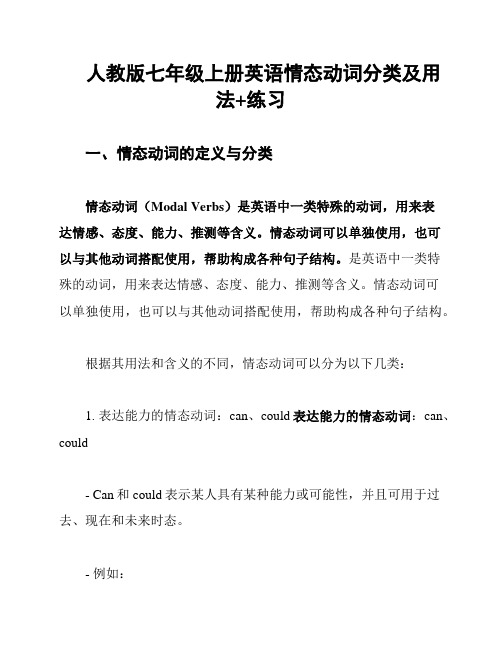
人教版七年级上册英语情态动词分类及用法+练习一、情态动词的定义与分类情态动词(Modal Verbs)是英语中一类特殊的动词,用来表达情感、态度、能力、推测等含义。
情态动词可以单独使用,也可以与其他动词搭配使用,帮助构成各种句子结构。
是英语中一类特殊的动词,用来表达情感、态度、能力、推测等含义。
情态动词可以单独使用,也可以与其他动词搭配使用,帮助构成各种句子结构。
根据其用法和含义的不同,情态动词可以分为以下几类:1. 表达能力的情态动词:can、could表达能力的情态动词:can、could- Can和could表示某人具有某种能力或可能性,并且可用于过去、现在和未来时态。
- 例如:- I can speak English fluently.(我能够流利地说英语。
)- She could swim when she was five years old.(她五岁时就会游泳了。
)2. 表示推测的情态动词:may、might表示推测的情态动词:may、might- May和might表示推测、猜测,并且表示可能性。
- 例如:- He may be at home.(他可能在家。
)- They might arrive late.(他们可能会迟到。
)3. 表示允许和许可的情态动词:may、can表示允许和许可的情态动词:may、can- May和can可以用来表示允许或许可。
- 例如:- Can I have some water, please?(请给我一些水好吗?)4. 表示义务和建议的情态动词:must、should表示义务和建议的情态动词:must、should- Must表示义务,表示某事必须要做。
- Should表示建议,表示某事是应该要做的。
- 例如:- You must finish your homework before you go out.(你必须在出门前完成作业。
)- You should drink more water.(你应该多喝水。
人教七年级英语上册:全册语法+配套练习

人教七年级英语上册:全册语法+配套练习+答案一、代词1、人称代词和物主代词英语的人称代词(Personal Pronoun)有三种不同的人称形式:第一人称(First Person);第二人称(Second Person);第三人称(Third Person)。
三种人称又各有单、复数形式。
.在上列人称代词的不同形式中,还包含了主格(Subjective Case)、宾格(Objective Case)两种“格”的形式。
这样,从“格”的形式来划分,英语的人称代词又可归纳为:主格:I,you,he,she,it,we,you,they宾格:me,you,him,her,it,us,you,them此外,还有所有格形式。
属格:my,mine,your,yours,his,her,hers,its,our,ours,their,theirs 属格又可分为两类:一类是形容词性物主代词(my,your,his,her,its,our,their)即“物主限定词”;另一类是名词性物主代词(mine,yours,his,hers,ours,theirs),即“物主代词”。
人称代词第一人称第二人称第三人称单数复数单数复数单数复数主格I we you you she\ he\ it they 宾格me us you you her\ him\ it them物主代词形物代my our your your her \his\ its their 名物代mine ours yours yours hers/his/its theirs人称代词用法:(1)人称代词主格:做主语,表示谁怎么样了,干什么了。
I am a teacher.You are student.He is a student , too.We/You/They are student.(2)人称代词宾格:作宾语,表示动作行为的对象,一般放在动词的后面。
人教版初中英语动词分类表
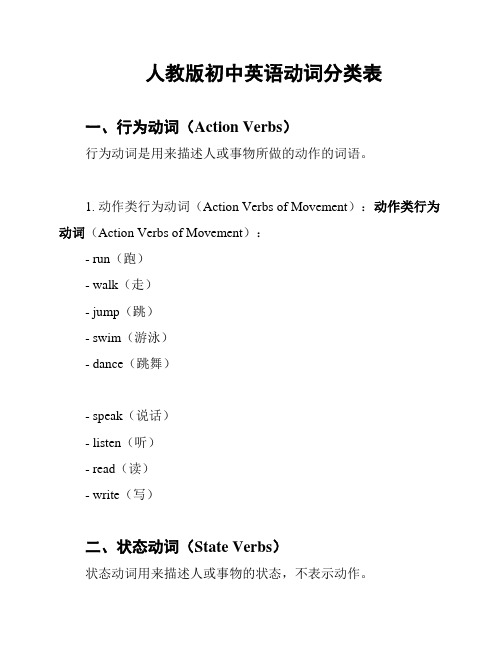
人教版初中英语动词分类表一、行为动词(Action Verbs)行为动词是用来描述人或事物所做的动作的词语。
1. 动作类行为动词(Action Verbs of Movement):动作类行为动词(Action Verbs of Movement):- run(跑)- walk(走)- jump(跳)- swim(游泳)- dance(跳舞)- speak(说话)- listen(听)- read(读)- write(写)二、状态动词(State Verbs)状态动词用来描述人或事物的状态,不表示动作。
1. 感官类状态动词(State Verbs of Senses):感官类状态动词(State Verbs of Senses):- see(看见)- hear(听见)- smell(闻到)- taste(品尝)- feel(感觉)2. 心理类状态动词(State Verbs of Mental Processes):心理类状态动词(State Verbs of Mental Processes):- think(思考)- believe(相信)- know(知道)- prefer(更喜欢)- remember(记得)三、延续性动词(Continuative Verbs)延续性动词用来表示一个动作或状态的持续性。
1. 持续动作类延续性动词(Continuative Verbs of Continuous Action):持续动作类延续性动词(Continuative Verbs of Continuous Action):- study(研究)- work(工作)- sing(唱歌)- play(玩)- sleep(睡觉)2. 持续状态类延续性动词(Continuative Verbs of Continuous State):持续状态类延续性动词(Continuative Verbs of Continuous State):- exist(存在)- belong(属于)- lie(躺)- sit(坐)- stand(站)四、完成性动词(Perfective Verbs)完成性动词用来表示一个动作或状态的完成。
七年级上(人教版)英语期末考试复习之动词及主谓一致
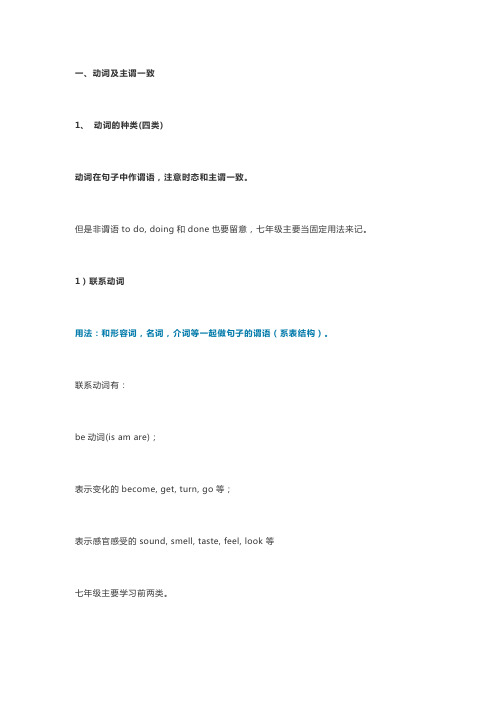
一、动词及主谓一致1、动词的种类(四类)动词在句子中作谓语,注意时态和主谓一致。
但是非谓语to do, doing和done也要留意,七年级主要当固定用法来记。
1)联系动词用法:和形容词,名词,介词等一起做句子的谓语(系表结构)。
联系动词有:be动词(is am are);表示变化的become, get, turn, go等;表示感官感受的sound, smell, taste, feel, look等七年级主要学习前两类。
2)情态动词情态动词有can, may, need, must等情态动词不能单独作谓语,与行为动词一起作谓语。
3)助动词助动词帮助构成完整谓语,自身没有意义:do does(疑问句,否定句);be(构成进行时);have(构成完成时)4)行为动词行为动词表示行为动作。
take 、bring、eat、have、like、sell、buy、play、see、go、watch 等2、主谓一致及动词的第三人称单数主语是单数名词,第三人称单数(he, she和it),不可数名词),谓语动词用第三人称单数。
be的第三人称单数形式“is”;行为动词一般加“s”;(否定句、一般疑问句和特殊疑问句,用助动词does 帮助构成)情态动词没有第三人称单数形式附:第三人称单数形式的构成:“动词原形+ s/es”(1)、一般情况,动词后直接加s (清辅音后读/s/,浊辅音,元音后读/z/)例如:falls, looks, grows, plants,(2)、以字母e 结尾的动词,直接加s (读/z/)例如:comes, takes(3)、以字母s, x, ch, sh, o结尾的动词,加es ( 读/z/ 或/Iz/)例如: finishes, does, goes, watches, fixes, washes(4)、以“辅音字母+ y”结尾的动词,变y 为i,加es (读/ z /)例如: studies注意:元音字母+ y结尾的动词,如enjoy play等,直接加“s”(5)、have的第三人称单数形式为“has”可数名词复数构成规则与动词三单一样!复习题一用be动词的适当形式填空。
人教版(2024)英语七年级上册+Unit+3+My+School+语法讲解及练习

新人教版unit 3 My School 语法讲解及练习there be句型的用法一、定义“there be”句型是英语中常用句型,表示“有”,用于描述人或事物的存在或某地有某物。
在这种句型中,there作为引导词放在句首,be动词的某种形式作为谓语,名词或名词词组作为句子的真正主语放在be动词之后,句子最后为地点或时间状语。
在这种句型中,谓语应和后面的主语取得一致,即主语是单数时用there is,主语是复数时用there are。
如果句中有两个或两个以上的主语时,谓语动词常和最靠近它的主语保持一致。
二、there be句型与have has的区别there be表示在某地有某物(或人);have(has)表示某人拥有某物,have(has)前面必须有主语。
有助动词does引导第三人称单数的疑问句和否定句时,动词用原形,has的原形是have,所以has改成have。
三、there be句型的结构There be句型的基本结构为:There is/are + 名词+ 地点/时间。
在这个结构中,There是引导词,没有实际意义,is/are是谓语动词,后面的名词是句子的主语,表示存在的人或物,最后的地点或时间状语描述存在的位置或时间。
结构1.There is+a/an+单数可数名词+地点状语There is a ruler on the desk.书桌上有一把尺。
2.There are+复数可数名词+地点状语There are four apples on the tree.树上有四个苹果。
There are some flowers in the park.公园里有许多花。
3.There is +不可数名词+地点状语例:There is some water in the bottle.瓶子里有一些水。
(水是不可数名词,即使有some,be动词也是单数。
)就近原则重点考点:There be句型中,几个名词并列时,be的单复数形式由最近名词单复数决定。
新版人教版七年级上册英语动词表

新版人教版七年级上册英语动词表1. be(是)- am(我是)- is(他/她/它是)- are(我们/你们/他们是)2. have(有)- has(他/她/它有)- have(我们/你们/他们有)3. do(做)- does(他/她/它做)- do(我们/你们/他们做)4. go(去)- goes(他/她/它去)- go(我们/你们/他们去)5. like(喜欢)- likes(他/她/它喜欢)- like(我们/你们/他们喜欢)6. want(想要)- wants(他/她/它想要)- want(我们/你们/他们想要)7. study(研究)- studies(他/她/它研究)- study(我们/你们/他们研究)8. eat(吃)- eats(他/她/它吃)- eat(我们/你们/他们吃)9. drink(喝)- drinks(他/她/它喝)- drink(我们/你们/他们喝)10. see(看见)- sees(他/她/它看见)- see(我们/你们/他们看见)11. hear(听见)- hears(他/她/它听见)- hear(我们/你们/他们听见)12. play(玩)- plays(他/她/它玩)- play(我们/你们/他们玩)13. watch(看)- watches(他/她/它看)- watch(我们/你们/他们看)14. read(读)- reads(他/她/它读)- read(我们/你们/他们读)15. write(写)- writes(他/她/它写)- write(我们/你们/他们写)16. listen(听)- listens(他/她/它听)- listen(我们/你们/他们听)17. sleep(睡觉)- sleeps(他/她/它睡觉)- sleep(我们/你们/他们睡觉)18. run(跑)- runs(他/她/它跑)- run(我们/你们/他们跑)19. walk(走)- walks(他/她/它走)- walk(我们/你们/他们走)20. stop(停止)- stops(他/她/它停止)- stop(我们/你们/他们停止)。
- 1、下载文档前请自行甄别文档内容的完整性,平台不提供额外的编辑、内容补充、找答案等附加服务。
- 2、"仅部分预览"的文档,不可在线预览部分如存在完整性等问题,可反馈申请退款(可完整预览的文档不适用该条件!)。
- 3、如文档侵犯您的权益,请联系客服反馈,我们会尽快为您处理(人工客服工作时间:9:00-18:30)。
学习必备欢迎下载七年级英语动词分类及用法动词 (v.):一般情况下,按照作用和用途,英语动词可分为三类:be 动行为动词、助动词。
be 动词表示状态, 情态动词表示说话人的情法,行为动词表示动作,助动词没有实际词意,只起语法作用。
一、 be 动词 :英语中be 动词也叫系动词,基本形式有am, is, are 三种。
其用法am,你 (you) 用 are, is 用于他 (he),她 (she),它 (it) ;单数名词用is,复数名词全用are.变疑问,往前提,句末问号莫丢弃。
变否定,更容易,be 后 not 莫忘记。
疑问否定任你变,句首大写莫迟疑。
be 动词练习1.I ________ from Australia.2.She _______ a student.3.Jane and Tom _________ my friends.4.My parents _______ very busy every day.5.Where _________ you from?6._________ they your new friends?7.The girl______ Jack's sister.8.The dog _______ tall and fat.9.Jack ’ s friend ______ in Class One.10.Where _____ your mother? She ______ at home.11.Whose dress ______ this?12.That ______ my red skirt.14.These _____ buses.15.Some tea ______ in the glass.学习必备欢迎下载本身无实意,只有实意动词作谓语时才涉及使用,起到辅助作用。
常见do/does/did ,后 +V 原。
如:I like it.-------- Do you like it?Michael likes Chinese Food.---- No, he doesn't.Jane and Helen like music.---- they don't.Does Michael like Chinese food? Do Jand and Helen like music?Ye s助动词练习1: She ________ to see documentaries (记录片) .A 、 do wantB 、 don't want C、 doesn't want D 、no2: Look at that picture on the wall. __________ you like it?A 、 DoB 、 Can C、 Could D 、 Are3: He ________ like pears.A 、 do B、 is C、 doesn't D 、 not4:— Do you often go to the cinema______ Sunday?—No,we___A 、 on, don'tB 、 on, aren't C、 in, do D 、 in, don't 5: Li Lei ______ lunch at home.A 、 hasn ’ tB 、 haven ’ tC 、 don ’havetD 6:— Does the boy want to be an actor?—________.A 、 Yes, he is B、 No, he does C 、 Yes, he doesD、7: _________ he have any apples ?A 、 DoB 、 Does C、 IsD、8: She ______ want to be a policewoman, because she thinksit ’kin dsA 、’ tB 、 aren ’C 、 don ’ tD、9Why ____he have brown hair?:Ado B、does C、 is D 、学习必备欢迎下载C、 Is, have, isn't D 、 Does, have, doesn't 13: I ________ have a watch.A 、 am not B、 does C、 don't14:____you ____ a good time on your vacation?A 、 Did; haveB 、 Did; had C、 Were; have 15: Simon likes _____ football, but he doesn’tit well.A 、 play, plays B、to play, plays C、plays, playing 16: She____ have to wash the dishes now.A 、 don't B、 not C、 doesn't 17:— ________Colin ________ Chinese history?—Yes, he does.A 、 Do; like B、 Does; likes C、 Do; likesD D 、D D三、实意动词:即行为动词,表示动作的动词。
它有时态及人称和数的变化。
变否定句词前加助动词don’t或 doesn’变t,疑问句在句首加do 或 does。
常见的实意动词有: go, come, walk, ride, drive, watch, begin, listen, sw make, clean, dance, sing, borrow, use, keep, return, sit, write, draw, learn, stud sleep, move, miss, stop, hurt, lose, cross, turn, speed, enjoy, fall, forget, bring,blow, start, climb, rain, snow, remember,travel, hope, prepare, decide, arri 实意动词分及物动词(后跟有宾语)和不及物动词(不跟宾语)。
不及物动词少,常见的不及物动词有look (at), listen(to), live(in), w (in\at) 等等。
实意动词练习1.He ____________ (live) in Beijing for several days every year.2.Ms. Lin _____________ (teach) English in our school3.He always________ (have)dinner at home.4.She and I ________ (watch) TV in the evening.学习必备欢迎下载11.Liu Tao _________ (do) not like PE.12.I can ________ (draw) many beautiful pictures13. 听老师_________________ 等公共汽车_______________到达北京_________________ 看我_________________四、情态动词:情态动词是一种本身有一定的词义,表示说话人的情绪、态度或语气的动词不能单独作谓语,只能 +动词原形 ,构成复合谓语,没有人称和数的变化如: I can speak Chinese. 2. He can sing English songs.常见的情态动词: can (could), may (might), shall (should), will (wo had better, have to 等等,否定直接在后面加not如: We can be there on time tomorrow. 我们明天能按时去那儿。
May I have your name? 我能知道你的名字吗?情态动词练习1. The children___ play football on the road.A. can'tB. canC. mustn'tD. must2. ----Can you speak Japanese? ----No, I____.A. mustn'tB. can'tC. needn'tD. may not3.- Can you see a light on the table?-Yes, ________.A 、 I am B、 I ’mnot C、 I can D 、 He isn ’4._________ I come in ?5.I _________ speak a little French.6.The red light( 灯 ) is on. We __________ stop.7.I _________ drive a car.8.He is a dancer. He can ____________ (dance) very well.9.Would you please _______________ (help) me。
